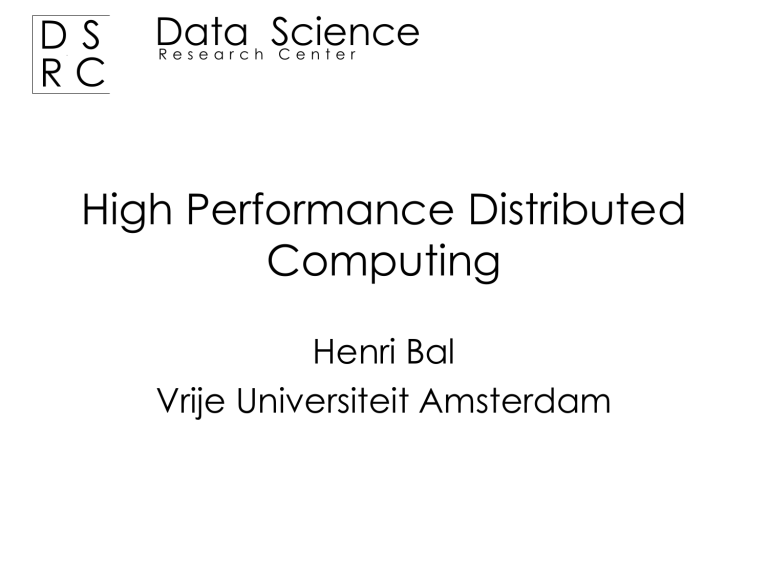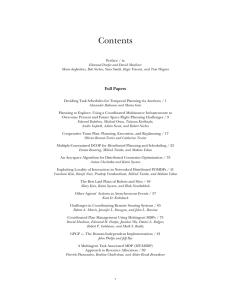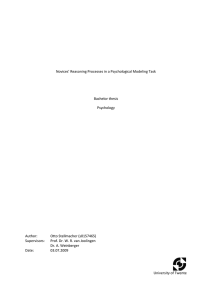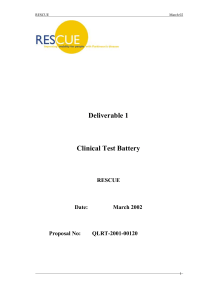backward-chaining + - Department of Computer Science

D S
R C
Data Science
R e s e a r c h C e n t e r
High Performance Distributed
Computing
Henri Bal
Vrije Universiteit Amsterdam
D S
R C
Outline
1. Development of the field
2. Highlights VU-HPDC group
3. Links to data science cycle
4. Conclusions
D S
R C
Developments
• Multiple types of data explosions:
– Big data: huge processing/transportation demands
– Complex heterogeneous data
LOFAR: ~15 PB/year
SKA: >300 PB/year, exascale processing
Complex data
D S
R C
Developments
• Infrastructure explosion
– High complexity: heterogeneous systems with diversity of processors, systems, networks
D S
R C
VU HPDC GROUP
• Bridge the gap between demanding applications and complex infrastructure
• Distributed programming systems for
– Clusters, grids, clouds
– Accelerators (GPUs)
– Heterogeneous systems (``Jungles”)
– Clouds & mobile devices
• Applications: multimedia, semantic web, model checking, games, astronomy, astrophysics, climate modeling ….
D S
R C
Highlights VU-HPDC group
Solved Awari 2002
AAAI-VC 2007 DACH 2008 - BS DACH 2008 - FT
3rd Prize: ISWC 2008 1st Prize: SCALE 2008 1st Prize: SCALE 2010 EYR 2011
Sustainability award
D S
R C
Links to data science cycle
Decision
Theory
Visual
Analytics
Understand and decide
Perception
Cognition
Distributed
Processing
Distributed reasoning
Reasoning
Knowledge representati on
Large Scale
Databases
Store and process
Software
Eng.
System /
Network
Eng.
Analyze and model
Multimedia
Retrieval
Information
Retrieval
Machine
Learning
Modeling and simulation
D S
R C
Reasoning – Semantic Web
• Make the Web smarter by injecting meaning so that machines can “understand” it.
o initial idea by Tim Berners-Lee in 2001
• Now attracted the interest of big IT companies
D S
R C
Google Example
D S
R C
Google Example
D S
R C
Distributed Reasoning
• WebPIE: web-scale distributed reasoner doing full materialization
• QueryPIE: distributed reasoning with
backward-chaining + pre-materialization of schema-triples
• DynamiTE: maintains materialization after updates (additions & removals)
Challenge: real-time incremental reasoning on web scale, combining new (streaming) data & existing historic data
With: Jacopo Urbani, Alessandro Margara, Frank van Harmelen
COMMIT/
D S
R C
Glasswing: MapReduce on Accelerators
• Use accelerators as a mainstream feature
• Massive out-of-core data sets
• Scale vertically & horizontally
• Code portability using OpenCL
• Maintain MapReduce abstraction
With: Ismail El Helw, Rutger Hofman
D S
R C
Glasswing Pipeline
• Overlaps computation, communication & disk access
• Supports multiple buffering levels
D S
R C
Evaluation of Glasswing
• Glasswing uses CPU, memory & disk resources more efficiently than Hadoop
• Compute-bound applications benefit dramatically from GPUs
• Better scalability than Hadoop
• Runs on a variety of accelerators
• E.g. k-means clustering:
– 8.5
× (1 node) vs.
15.5
× (64 nodes) vs.
107 × (GPU node)


